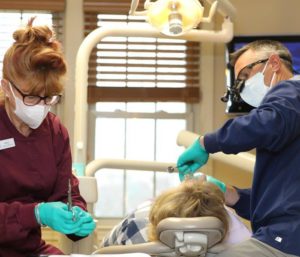How Are Heart and Oral Health Related?
February 27, 2021
Valentine’s Day is a widely celebrated holiday in February, but there is another reason to be thinking about your heart. This month is Heart Health Month. There is no better time for you to learn about how your cardiovascular and oral healthy are related. In order to keep your heart strong, you should be focusing on your oral hygiene routine. Continue reading to learn about their connection.
“IT’S JUST A CLEANING”
February 22, 2021
 This is a phrase we hear far too frequently when patients call to cancel or change their dental hygiene appointments. When the patient is told that there are no open hygiene appointments for 4-6 months, the response is often, “Oh, that’s okay, it’s just a cleaning.” This lack of concern is only partly to blame on the patient; most of the accountability falls in the lap of the dental team.
This is a phrase we hear far too frequently when patients call to cancel or change their dental hygiene appointments. When the patient is told that there are no open hygiene appointments for 4-6 months, the response is often, “Oh, that’s okay, it’s just a cleaning.” This lack of concern is only partly to blame on the patient; most of the accountability falls in the lap of the dental team.
If you read this column with any frequency, I am sure you have seen me report that 75% of the population has some form of periodontal (gum) disease. I’m sure you have also read that periodontal disease has been linked to heart disease, stroke, pre-term, low birth-weight babies, diabetes, and possibly even some types of cancer. The problem is the dental team is not discussing this enough with their patients.
Here’s the way I see it: If a patient has made the decision to seek the services of a dental office, we must assume that the reason is based on wanting to improve and/or maintain their dental health. If that’s not the reason you go to the dentist, what is? Patients will often say during an exam, “Please don’t find anything.” Our response may be, “Well then, I better not look.” Assuming the reason for going to a dental office is to improve and/or maintain dental health as part of overall health, it is the obligation of the dental team to “find stuff” if it’s there, communicate that with the patient, and have a conversation about whether any steps should be taken.
For example, based on your level of periodontal health, there are different levels of frequency recommended for hygiene visits. The majority of patients should be seen every 6 months. Some are lucky enough to have yearly visits recommended to them. For others, every 3 or 4 months is recommended. This frequency is determined by your dental team to maintain your dental health. Regardless, if you put off your routine care by 1, 2 or even 6 months, that is a lot of time to have bacterial growth accumulate and put your body into a defensive mode due to increased inflammation. This brings me back to the reason you have chosen to be an active dental patient.
Remember, gum disease is not only bad because it makes your breath stink and your teeth fall out; it is bad for you systemically because of chronic inflammation. You may very well not notice an increase in inflammation, but your body does. There are measurable indicators of this.
If your goal is optimal health, routine maintenance is essential. I tell my team all the time that we must continue to educate the people who put their trust in us to maintain their dental health.
Depending on your car, there is a recommended maintenance schedule. If you ignore the recommended maintenance, only bad things can happen. You may be able to “stretch it out” a little, but must understand there are risks associated with that decision. If you knew how bad chronic inflammation really was for you, you would want to be seen more frequently than you are.
There are obviously valid reasons why patients need to change an appointment. Most dental offices understand that. It is the frequency, attitude (It’s just a cleaning), and lack of commitment that causes both disruption within the dental office and discontinuity of care.
Dr. St. Clair maintains a private dental practice in Rowley and Newburyport dedicated to health-centered family dentistry. If there are certain topics you would like to see written about or questions you have please email them to him at jpstclair@stclairdmd.com. You can view all previously written columns at www.jpeterstclairdentistry.com/blog.
THE PATIENT PERSPECTIVE -PART 2
February 17, 2021
“There’s not enough time in the day.” Have you ever used this excuse? I said it yesterday to someone. We all tend to waste a lot of time, or at least don’t use the time we have as effectively as we could. You would think that in our technology-filled world, time management would be easier. I think that some of this technology gets in the way by adding even more of a time commitment to things that reduce interpersonal communication.
Here’s an example. It’s time to buy a new car. There are many different car brands, and within those brands are many models. No matter what dealership you go to, they will gather a minute amount of information about you, or maybe none at all, but guaranteed, they have a car on their showroom floor that they tell you is the right car for you. They will spend a countless amount of time talking about the many new features that their brand has, and the options between different models. If the salesman worked for a different car company, or if you went to a different dealership, you would hear the same reasons why that brand is right for you. Their goal is to sell you a car.
Dental offices can be like that too. If the dentist spent all their time talking about the array of technological gadgets and how they were right for you, how would you feel? You would feel like you were trying to be “sold” something. Having said that, there are many great technological gadgets that improve the whole experience of patient care out there. There are also many ways to do most things, but technology is not the solution; it is simply a tool used in patient care.
Branding draws us in. You may have a preconceived notion that a particular make of car is what you “need”, or see a dental advertisement that attracts your attention, such as “invisible” braces. However, there are many different brands of cars and dental aligners that would satisfy your needs.
Whether it is a car or teeth, there are often gaps between the “seller” and the “buyer”. There is a gap between what we really need and what we think we need. There is another gap between what the dentist or salesman thinks we need, and what we think we need. And, more specifically, there is often a serious gap between the value most dentists have, and the value they feel they can discuss with patients. Sometimes we feel we don’t have the time to discuss these things, and other times we are afraid we will scare you away.
Dental care is such an important part of overall wellness. Remember, just because it doesn’t hurt does NOT necessarily mean everything is okay. Collaboration with a dental team who puts the patient’s best interests first is key to good dental care.
Dentists and dental team members need to communicate facts and truths. They need to convey expertise and enthusiasm. This goes back to the idea of time I have mentioned so often in the past. Dentists and dental teams need to spend time with patients, be involved with co-diagnosing issues with patients, not hard-selling with little information. This creates a caring environment where the patient can be involved in the process of choosing the level of care that is right for them.
Dr. St. Clair maintains a private dental practice in Rowley and Newburyport dedicated to health-centered family dentistry. If there are certain topics you would like to see written about or questions you have please email them to him at jpstclair@stclairdmd.com. You can view all previously written columns at www.jpeterstclairdentistry.com/blog.
THE PATIENT PERSPECTIVE -PART 1
February 8, 2021
 Patients see things differently than dentists. Often, what is important to dentists is not important to patients, and vice versa. This seems like the obvious, but dentists often have a blind spot when it comes to seeing things from a patient’s viewpoint.
Patients see things differently than dentists. Often, what is important to dentists is not important to patients, and vice versa. This seems like the obvious, but dentists often have a blind spot when it comes to seeing things from a patient’s viewpoint.
We often have a similar blind spot in our ability to communicate with patients. When asked to rate their ability to communicate with patients, 60% of physicians rated themselves in the top 10%.
Dentists would probably have similar results.
Communication is key to any relationship. Why then do healthcare professionals, dentists specifically, often have poor communication skills with their patients? There is no one answer to this question, but we (dentists) all struggle with communicating with patients at some level…..and COVID doesn’t make it any easier by always needing to have a mask on during conversations.
Dentists often get a bad rap – in the media, interpersonally, and even in the movies. We (dentists) are often starting at a disadvantage in the relationship with our patients. Some patients, who may really need and want care, have preconceived notions, such as fear without basis, an unpleasant past experience, or the idea that they just can’t afford it. It is more difficult to build a trusting relationship in these situations. Of course, there are many patients who love their dental office, but there are still even many of those patients who dentists have trouble communicating with.
I think the biggest problem we (dentists) have in many of these communication issues is time. Dentistry is a business, and an expensive business to run efficiently. When time is money, dental income to support the business comes from work being done in the chair. This creates yet another blind spot for the dentist.
Dentists may be great tooth fixers but in general are poor communicators. Anyone can drill on a tooth but not everyone has meaningful communication skills. When was the last time a dentist sat down with you for an extended conversation to discuss your personal situation, the importance and relevance to getting good dental care, and its significance to systemic health? When was the last time a dentist helped you work through your particular barrier (fear, money, time, lack of concern, trust) to getting a healthier mouth? I know I have room for improvement.
Meaningful communication skills come more easily to some than others. For most of us, it seems it is always a work in progress. I’m sure you can think of numerous past experiences of poor communication and realize later how the situation could have been better handled. I can think of many. Our way of communicating is often engrained in us. If we wish to improve our communication skills, we (dentists and everyone) must first become aware or more mindful of these interactions. Only then can we work on improving this skill. That takes time, and time is again a factor.
Dentists need to recognize, fully understand and be able to manage the different barriers that prevent patients from getting the care they deserve. Every patient has their own issues, their own concerns, their own personality and their own true or false notions about dentists and dentistry.
Relationships take time to develop. Talk with your dentist about anything that is holding you back from improving your dental health. These conversations build trust. Trust is the key factor in the dentist-patient relationship.
….to be continued
Dr. St. Clair maintains a private dental practice in Rowley and Newburyport dedicated to health-centered family dentistry. If there are certain topics you would like to see written about or questions you have please email them to him at jpstclair@stclairdmd.com. You can view all previously written columns at www.jpeterstclairdentistry.com/blog.
CHEW ON THIS
February 1, 2021
 You may have heard your dental hygienist tell you to brush and floss more, but what about chewing more gum?
You may have heard your dental hygienist tell you to brush and floss more, but what about chewing more gum?
In a study published in PLOS One, researchers found that chewing gum may remove as much bacteria as brushing without toothpaste or flossing. The study was funded by Wrigley……ok, but it’s still interesting.
“This study was initiated as a method development study to determine the number of bacteria that are trapped in a piece of sugar-free gum,” said one of the authors. “According to our knowledge, this is the first time that an estimate of the number of bacteria trapped in a piece of chewed gum is determined.”
For their research, Wessel and colleagues included five healthy volunteers from the department of biomedical engineering and asked them to chew two types of commercially available sugar-free chewing gums for varying amounts of time up to 10 minutes.
“We discuss [in the study] that by targeting different areas in the mouth, sugar-free chewing gum removes comparable amounts of bacteria to those removed by flossing and a clean toothbrush without toothpaste,” Wessel said. “This was done for perspective only and not meant to compare effectiveness of both techniques.”
The researchers used numerous methods to quantify and qualify numbers of oral bacteria trapped in chewed gum. What they concluded was that daily gum chewing reduces the bacterial load in the oral cavity over time.
The maximum bacteria were trapped during the initial chewing period, after which a slow decrease over time up to 10 minutes was observed. This decline was seen with both methods regardless of the type of gum involved.
While the initial gum bases are most adhesive to oral bacteria, continued chewing changes the structure of the gum and decreases the hardness because of salivary uptake and release of water-soluble components, the study authors noted.
“This presumably affects the adhesion of bacteria to the gum, causing a release of initially trapped, more weakly adhering bacteria from the gum,” they wrote.
They reported that, assuming a volume of saliva of around 1 ml, their results indicate that chewing one piece of gum removes around 10% of the oral microbial load in saliva. They compared this to use of a new, clean toothbrush without any toothpaste, and found that it removed about the same amount of bacteria as the gum chewing. The mechanical action of floss removes a comparable number of bacteria, as established in an unpublished pilot study.
The authors emphasized that brushing and flossing remain more effective in reaching many areas in the mouth, and that sugar-free chewing gum should not be seen as a replacement, but as an addition to both techniques. The study findings may promote the development of gum that selectively removes specific disease-related bacteria from the human oral cavity, for instance by using porous type calcium carbonate, the authors noted.
Chew in moderation.
Dr. St. Clair maintains a private dental practice in Rowley and Newburyport dedicated to health-centered family dentistry. If there are certain topics you would like to see written about or questions you have please email them to him at jpstclair@stclairdmd.com. You can view all previously written columns at www.jpeterstclairdentistry.com/blog.







